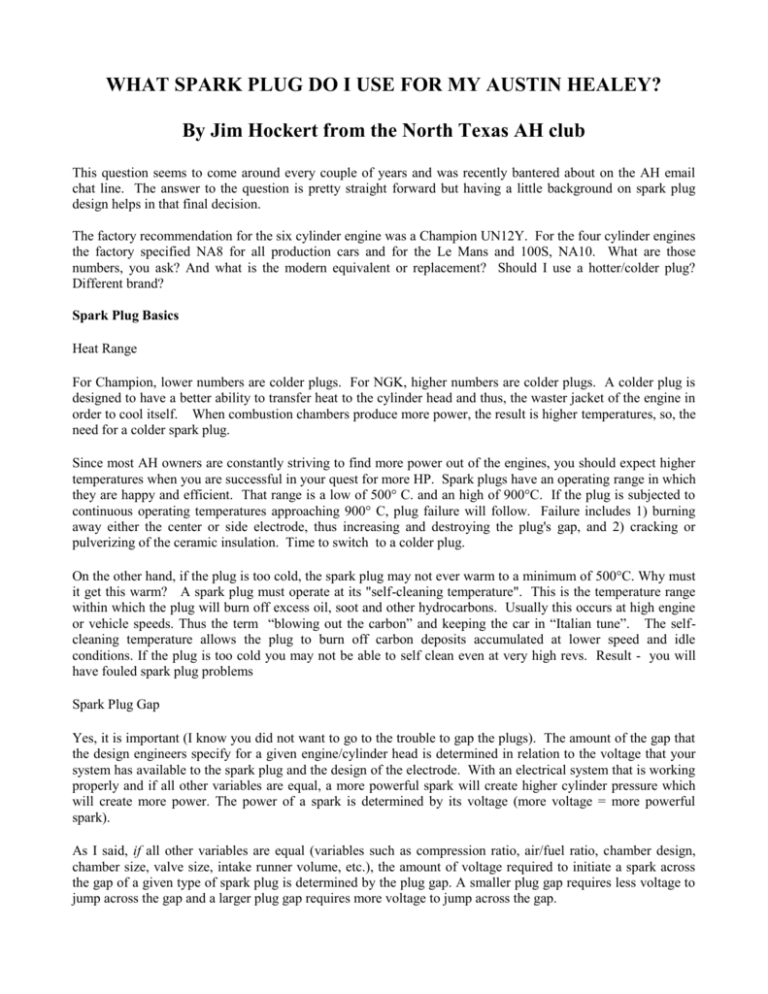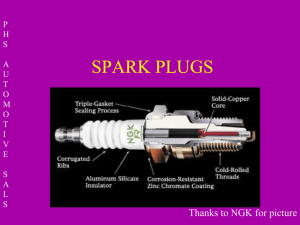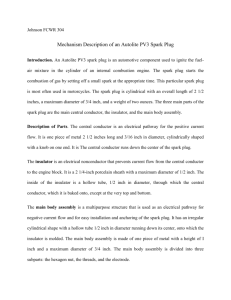Spark Plug Basics
advertisement

WHAT SPARK PLUG DO I USE FOR MY AUSTIN HEALEY? By Jim Hockert from the North Texas AH club This question seems to come around every couple of years and was recently bantered about on the AH email chat line. The answer to the question is pretty straight forward but having a little background on spark plug design helps in that final decision. The factory recommendation for the six cylinder engine was a Champion UN12Y. For the four cylinder engines the factory specified NA8 for all production cars and for the Le Mans and 100S, NA10. What are those numbers, you ask? And what is the modern equivalent or replacement? Should I use a hotter/colder plug? Different brand? Spark Plug Basics Heat Range For Champion, lower numbers are colder plugs. For NGK, higher numbers are colder plugs. A colder plug is designed to have a better ability to transfer heat to the cylinder head and thus, the waster jacket of the engine in order to cool itself. When combustion chambers produce more power, the result is higher temperatures, so, the need for a colder spark plug. Since most AH owners are constantly striving to find more power out of the engines, you should expect higher temperatures when you are successful in your quest for more HP. Spark plugs have an operating range in which they are happy and efficient. That range is a low of 500° C. and an high of 900°C. If the plug is subjected to continuous operating temperatures approaching 900° C, plug failure will follow. Failure includes 1) burning away either the center or side electrode, thus increasing and destroying the plug's gap, and 2) cracking or pulverizing of the ceramic insulation. Time to switch to a colder plug. On the other hand, if the plug is too cold, the spark plug may not ever warm to a minimum of 500°C. Why must it get this warm? A spark plug must operate at its "self-cleaning temperature". This is the temperature range within which the plug will burn off excess oil, soot and other hydrocarbons. Usually this occurs at high engine or vehicle speeds. Thus the term “blowing out the carbon” and keeping the car in “Italian tune”. The selfcleaning temperature allows the plug to burn off carbon deposits accumulated at lower speed and idle conditions. If the plug is too cold you may not be able to self clean even at very high revs. Result - you will have fouled spark plug problems Spark Plug Gap Yes, it is important (I know you did not want to go to the trouble to gap the plugs). The amount of the gap that the design engineers specify for a given engine/cylinder head is determined in relation to the voltage that your system has available to the spark plug and the design of the electrode. With an electrical system that is working properly and if all other variables are equal, a more powerful spark will create higher cylinder pressure which will create more power. The power of a spark is determined by its voltage (more voltage = more powerful spark). As I said, if all other variables are equal (variables such as compression ratio, air/fuel ratio, chamber design, chamber size, valve size, intake runner volume, etc.), the amount of voltage required to initiate a spark across the gap of a given type of spark plug is determined by the plug gap. A smaller plug gap requires less voltage to jump across the gap and a larger plug gap requires more voltage to jump across the gap. One way to reduce the amount of voltage required to fire across the gap of a spark plug is by increasing the number of sharp edges from which the spark can arc. This concept is the basis for racing spark plugs that offer several different types of center and side electrodes such as a “cut back” ground (or side) electrode that does not project over the center electrode. This provides more sharp edges and exposes more area to spark. Another example is the SplitFire™ plugs. A different manner of increasing the spark with equal voltage is the use of an electrode material that is a more efficient conductor than the standard steel material (like platinum). There is a drawback to these types of spark plugs, however. They will produce a less powerful spark than a standard spark plug will at the same gap. The spark is distributed over more area so it is weaker in each spot. In order to take advantage of this type of plug, your system really needs more voltage. If your ignition system is stock, you will not likely see an advantage from this type of spark plug. You are more likely to feel a drop in power. The proper gap for the factory ignition system is 0.032" to 0.035". If you must use platinum plugs the gap should be increased to .039 to .044 as this will offset the distributive effect described above. But remember you system may not be able to efficiently ionize this gap. Some companies, notably NGK, use a smaller diameter center electrode sometimes known as a “fine wire” spark plug. The smaller diameter center electrode has the effect of passing a stronger spark with a given voltage. Choosing a Spark Plug So what do you choose? Well, if you are concours, use the original spark plugs. If your car’s engine is essentially set up the way that it left the factory, use the factory recommended plugs. If you have added power improvements to your car (higher compression ratio, more cam, more carbs, electronic ignition, multi-spark discharge, more powerful coil), consider stepping up to the next colder heat range. Added real power? Move two steps colder. Then, read the plugs after 100 miles, 500 miles and 1,000 miles. If the plugs are fouling or coated with carbon, move back to the next hotter plug. If the ceramic is cracked or chalky or if either of the electrodes is burning away (the gap has increased) go colder. Now the Crossover Chart Type NGK Autolite BPR5ES 935, 945 2585, 3207 RN12YC RN11YC WR 9DC WR 8DC Original Equipment 100** 100 M** 100S** BP6ES BP8ES BP8ES 3464 2614 2614 NA8*, N5C NA10*, N3C NA10*, N3C W 7DC W 8DC W 8DC Racing Application Or B7ECS BPRC8EVX 4054 RN7YC4 N3C W 5CP W 4DP Next Colder than Original BR6ECS 3464 RN9YC W 7D Next Hotter than Original GR4 4055 RN14YC W 10DC Original Equipment Six Cylinder or Champion Bosch *Champion no longer makes NA8 and NA10; these are the modern equivalents. **These plugs seem to be reversed as the 100M and 100S should require the colder plug. Champion reversed their numbering system sometime in the last 45 years. N3C is colder than N5C. NA10 is colder than NA8.







